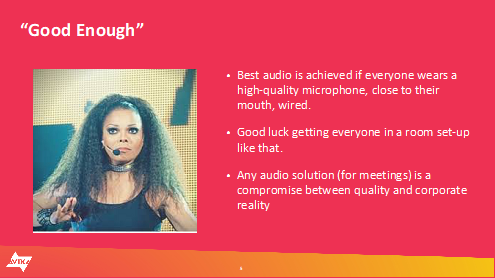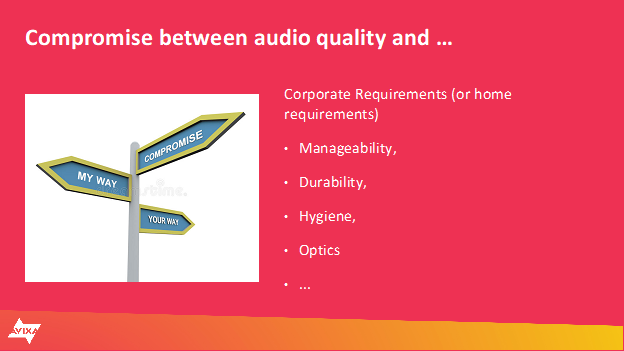Select the Right Microphone for Your Conferences and Meetings (and working from home, too)
Selecting the right microphone for your meeting rooms can be a daunting challenge. There are many options, capabilities, and price ranges. Which one is the right one?
Let me start by giving the answer before reviewing the differences: There is not “the one right microphone” that is the solution for all settings. Instead, the right microphone will depend on a lot of criteria, and your decision about which microphone to use should consider all of them.
Coming from a company known for world-class audio for commercial and entertainment applications as well as home use, making that statement objectively is difficult for me. But it’s true. The most important thing to do is to remember how you intend to use the microphones and what the environment is. You will not have the perfect conditions an artist has in the studio or on stage. You do not have a “front-of-the-house” person adjusting audio and channels to ensure best audio. You will have a meeting room or conference room with people coming in and out all day for their meetings. You will have to compromise and will not be able to achieve “perfect audio.” Instead, ensure that you achieve the right audio quality for the use case and the setting and that within these restrictions you generate the best possible audio. I call it “good enough” and do not mean that to be negative in any way.
RELATED: InfoComm 2020 Connected | Selecting and Adjusting Automatic Mixers
How to select the best type of auto-mixer for your project? Understand the differences among the three basic types of auto-mixers.

Why are there restrictions in the corporate setting, and what are they?
It starts with the location of the microphones. Entertainers use belt-pack and over-the-ear microphones to bring the microphone element as close to the sound source as possible. A corporate setting most likely uses table-top microphones that are at least a few feet away from the speaker, or ceiling or wall microphones that are tens of feet away from the speaker. Laws of physics make clear that the signal that arrives at these microphones compared to room noise has a lower signal-to-noise ratio than a microphone that is close to the sound source. Noise in the room includes installed components like projectors or lights, electronic hum, or air conditioning. And then there is noise from the participants in the meeting: Shuffling papers, using a laptop, clicking the mouse, breathing; all of that becomes part of the background noise in the room.
The effect of the noise becomes as simple as this: The farther away the microphone, the less sound pressure level comes from the person speaking, the more impact that noise has. Automatic gain control can only do so much; noise reduction as well. If the signal-to-noise ratio becomes too small, the microphone cannot make up for it. In addition, meeting and conference spaces often lack acoustic treatment, leading to a lot of reverberation (high RT-60 value), creating even more “noise.”

Besides the local audio issues caused by this, the acoustic echo canceller (AEC) required for a good conversation with remote participants via video, UC, or phone call, will also be less effective. A higher RT-60 value for example requires a long tail length in the AEC (the time in which the acoustic echo can be effectively cancelled).
Everything acoustically points to a microphone closest to the meeting participants. For corporate environments, that doesn’t work. Corporate requirements demand microphone placements that can range from “very visible, like a gooseneck microphone, right in front of the meeting participant” to “almost invisible, at the outer edges of the room.” That is where a compromise has to take place between the need for perfect audio and corporate requirements.
The use cases for the space in which the microphones are being installed also has an impact on microphone selection. A multipurpose room with changing table configurations is not very likely to have wired tabletop microphones installed, while a dynamic ceiling microphone or a wireless microphone solution might be perfect for such an environment. The corporate boardroom might have a table in which drilling is not allowed and a CEO user who, for confidentiality reasons, may not want microphones around when not required, which might necessitate only wireless microphones being allowed. The list goes on and on.

Because of COVID-19 and hygiene requirements that go along with it, companies must now think about how their equipment fits into their new corporate processes, cleaning, and social distancing requirements. And that is true not only for microphones. No-touch devices like ceiling microphones would seem to have an advantage over devices that might be touched and therefore cleaned. But then again, the touch controller on the table or the keyboard and mouse will require regular cleaning so a microphone would just be an additional device to be cleaned.
In conclusion, while there is no one-size-fits-all answer, the rule of thumb should be that the closer the microphone to the participants of the meeting, the better your audio will be. In the webinar, Select the Right Microphone for Conferences, Meetings, and Working from Home, I share my personal list of ‘best’ choices and share my reasons with you.
And remember the most important rule – bad audio is never good enough!




d6795920-eaf6-408e-b064-10b247156888.png?sfvrsn=6773b7ba_1)
